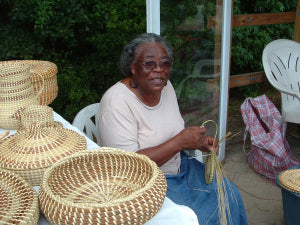
About Our Brand and Our Designs
Share
We frequently say our goal is to capture the spirit of Lowcountry living and the richness of our diverse cultural heritage. But what does that mean?
It means a lot. And more than we can cover in 1 blog post. But let's give a snippet.
Prior to the 1600's, the wilderness surrounded by various rivers that flow in and around the Lowcountry was inhabited by tidewater Indians for thousands of years before Europeans arrived. All were skilled hunters and thrived on the bounty of the land and waters. Native Americans used the Broad Path, which followed the Ashley River, to trade with neighboring tribes. (image credit to Sciway).

During the 1600's, some Native American tribes provided assistance to English colonists as they searched the area to build settlements. Other tribes were known to threaten early settlers with attacks. Homesteads and farms were established along the banks of the Ashley River and throughout the area.
During the 1600's it is estimated that about 1,000 adult French protestants fled to the British colonies to escape persecution in France. In 1680, the first group of French Protestants came to Carolina, followed by others in subsequent years. The Huguenot refugees who left France were generally merchants, artisans, craftsmen, wavers or were skilled in specific trades. Many were well-educated, and some established new roles as entrepreneurs or professionals where they settled. Many had to learn new skills to support themselves, learn new languages, and becoming planters and traders, and gradually becoming part of their new communities, while retaining their strong faith. Below is the French Huguenot church at the corner of Church and Queen St.

During the 1700's, over 60 plantations were established between the Ashley and Cooper Rivers. Great botanical and horticultural progress was made by Eliza Lucas Pinckney with the production of silk and indigo, and by Andre Michaux, the father of American horticulture, who established a botanical garden (near what is now Aviation Ave.) and introduced new plants to the area such as camellias and mimosas.
During the American Revolution (1775 - 1783), there were more battles fought in South Carolina than in any other state, and the Charleston area played a vital role in America’s independence. More on this in a later blog. Our brand's logo (below) incorporates the stars representing the 13 original colonies along with South Carolina's Crescent and Palmetto insignia.

To support the work on the plantations, slaves were brought in from Western Africa to the Lowcountry regions of South Carolina and Georgia. Bunce Island in Sierra Leone was a British slave castle from which many of the ancestors of today's Charleston residents originated. Using ship's manifests, genealogical records, oral histories and recorded songs, scholars continue to trace the first African arrivals who merged African, Native American and European cultures into what are now known as the Gullah-Geechee people.

The Gullah-Geechee are a distinctive group of African Americans whose origins lie along the coasts of North Carolina, South Carolina, Georgia and Florida, as well as the adjacent sea islands. This geographic dispersion dates back to the establishment of small, isolated African American farming and fishing communities, formed away from urban centers during and after slavery. Such communities have enduring relationships and traditions that have survived slavery, the Civil War, and the emergence of modern American culture. They speak a blended language, similar to that of Krio spoken in Sierra Leone and many are skilled in the creation of African styled handicrafts, like sweetgrass baskets and other art objects, enjoying a rich cuisine base upon seafood, vegetables and rice.
More to come ... including pirates!
credit to www.northcharleston.org; www.aftricanamericancharleston.com; www.huguenotsociety.org; tompoland.net/down-by-the-sweetgrass-highway/